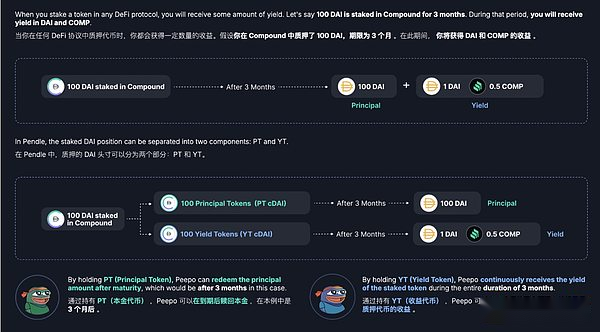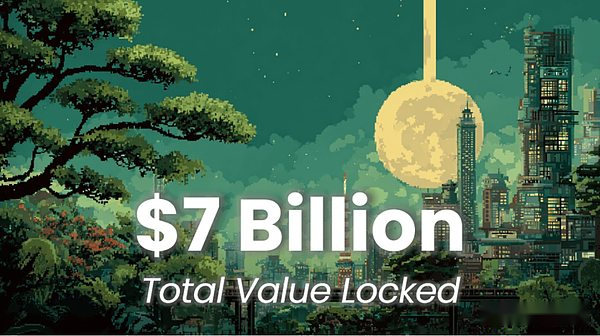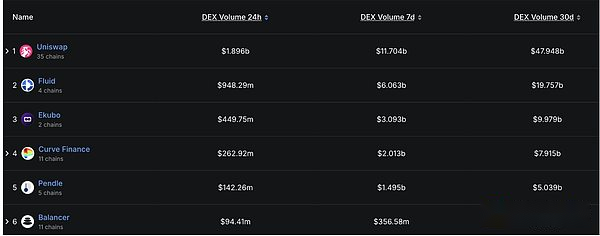
Author: Alex Liu, Foresight News
Pendle is the most successful DeFi protocol that has risen in this cycle, and does not even need to be modified with “one”.There are many articles explaining Pendle. This article aims to combine the latest developments and try to analyze the uniqueness of the protocol mechanism and value capture design behind Pendle’s success from a new perspective.Readers who are familiar with the Pendle mechanism can skip the previous explanation and read only the analysis of the following text.
What is Pendle
Pendle is a transaction “Yield Trading” agreement.To explain how to tradeincome, We introduce two assets of the synthetic stablecoin protocol Ethena, USDe and sUSDe as examples.
1 USDe SY is the same as the underlying asset 1 USDe, which is USD 1. For the convenience of explanation, we take 1 USDe (Sep 2025) PT = USD 0.99 and 1 USDe (Sep 2025) YT = USD 0.01.It is now about 1 month away from the deadline of September 2025.
As a trader, I now buy 10,000 YT for $100, which is equivalent to the income generated by 10,000 USDe in this month (i.e. Ethena airdrop points). After the expiration, the YT will be zeroed.Value transfer to undeclared Ethena airdrop points.The motivation for traders to buy is to be bullish on USDe’s earnings value, that is, they believe that the airdrop value of Ethena will be greater than the cost of purchasing YT.
leverage $10,000 to generate points for $100, thisPoints with small principal leverageThe ability to bring massive growth to Pendle under the previous points frenzy.YT traders are very successful: in order to obtain EigenLayer airdrop leverage eETH YT, the trader who recovered all the cost of YT from ETHFI’s airdrop and took free EIGEN tokens; when ENA was 0.2 US dollars, ENA rose above US$0.6 in 2 weeks, the value of the points increased significantly; Usual airdrop exceeded expectations, and the return on purchasing YT was more than 10 times.
USDe is a stablecoin with a value of 1:1 anchored to the USD. Simply holding USDe will not generate interest, but will generate Ethena’s airdrop points. After the airdrop of each quarter, it can be allocated to sENA tokens according to the number of points.sUSDe is the pledged version of USDe, a stablecoin that generates interest.Interest rates fluctuate between 5% and 15% with market sentiment and capital rates.The Ethena points obtained by holding sUSDe are lower than USDe.
For the above two assets, the income from holding USDe is Ethena points, and the income from holding sUSDe is interest and Ethena points.
Whether it is interest or points, they are actually very “time sensitive”.Interest rates may fluctuate violently with the market environment, and the value of points is closely related to the snapshot date and the real-time price of tokens.So the transaction’s “reward” requires athe term.It can be the gain in the next 3 months, but it should not be the gain in the next 300 years.
The income is generated by the underlying assets, and we will generate income after a certain period of time.Current ValueCalled “principal”, and we gathered 3 elements: principal, income and term.
Pendle packages incomeable assets with a unified token standard as standardized Yield (SY), and then splits them into principal tokens (PT) and Yield Token (YT) and sets a period, so that the “returns” within a certain period can be traded.

Before expiration, holding YT will receive the corresponding underlying tokens.After expiration,The value of PT will be equal to SY, and the value of YT will be zeroed.(If the period is 10 days away, YT represents the income of the underlying asset for 10 days, which is valuable; after maturity, it represents the income of the underlying asset for 0 days, which is worthless.)
For example, 1 USDe can be packaged as 1 standard income token USDe (Sep 2025) SY that expires in September 2025, and then split into 1 USDe (Sep 2025) PT and 1 USDe (Sep 2025) YT, and the value between them is compliant:
1 USDe (Sep 2025)SY = 1 USDe (Sep 2025)PT + 1 USDe (Sep 2025)YT.

1 USDe SY is the same as the underlying asset 1 USDe, which is USD 1. For the convenience of explanation, we take 1 USDe (Sep 2025) PT = USD 0.99 and 1 USDe (Sep 2025) YT = USD 0.01.It is now about 1 month away from the deadline of September 2025.
As a trader, I now buy 10,000 YT for $100, which is equivalent to the income generated by 10,000 USDe in this month (i.e. Ethena airdrop points). After the expiration, the YT will be zeroed.Value transfer to undeclared Ethena airdrop points.The motivation for traders to buy is to be bullish on USDe’s earnings value, that is, they believe that the airdrop value of Ethena will be greater than the cost of purchasing YT.
leverage $10,000 to generate points for $100, thisPoints with small principal leverageThe ability to bring massive growth to Pendle under the previous points frenzy.YT traders are very successful: in order to obtain EigenLayer airdrop leverage eETH YT, the trader who recovered all the cost of YT from ETHFI’s airdrop and took free EIGEN tokens; when ENA was 0.2 US dollars, ENA rose above US$0.6 in 2 weeks, the value of the points increased significantly; Usual airdrop exceeded expectations, and the return on purchasing YT was more than 10 times.

In addition to Ethena points, holders of sUSDe YT can also obtain interest generated from underlying assets.Although the YT value is zeroed after maturity, holders can receive USDe income generated by the underlying sUSDe assets at the Pendle contract based on the actual interest rate.
Of course, there are also cases of loss in YT trading: leverage a project with YT, but the project has not issued coins for a long time, and the value of the points is infinitely diluted; long at an implied interest rate (implied APY) of 8% exists in the underlying income of USDT in Aave. As a result, as the market environment deteriorates, the actual average interest rate within the term is 4%, and purchasing YT will lose half of the principal.
Trading requires an opponent.Behind the hot YT trading, the market needs to have demand for PT to support liquidity.In the above case, you can buy 10,000 USDe (Sep 2025) PT for US$9,900, and you can exchange it for 10,000 USDe if it expires in 1 month.Earning 1% in January is equivalent to locking in about 12% of the annualized period in January and enjoying a “fixed interest rate”.
This is also the model of government bonds. I bought a 1-year government bond with a denomination of 110 yuan for 100 yuan. When I expire, I received 110 yuan for treasury bonds, and when I bought, I locked in a 10% annualized return.Similarly, the closer the national bonds are to their redemption period, the closer they are to their face value, and can be redeemed in equal amounts when they are maturing.
As the seller of the income, PT holders sell the “uncertainty” of the income, locking in the “fixed interest rate”.
The LP of Pendle (Liquidity Provider, liquidity provider) is equivalent to holding SY and PT at the same time and selling part of YT.In addition to the fixed income generated by its PT part, LP can also obtain token emission income (liquidity mining) from PENDLE.
It’s not difficult to see,Pendle allows users who want to reduce risks and increase stable returns, users who want to take risks and increase potential uncertain returns, and users who simply want to mine DeFi have a choice.It solves the user’s urgent needs and adopts it naturally.
Pendle’s data
The data illustrates the problem.Despite the market downturn last week and Pendle’s largest asset maturity in history (meaning that some users who pursue stable returns have achieved “profit settlement”), Pendle’s TVL (total locked value) still hit a new high, reaching US$7 billion.

More than 48% of Ethena assets were packaged as Pendle assets, reaching $4.6 billion.More than 4 billion Pendle PT assets are deposited as collateral in loan agreements such as Aave, Morpho, Euler, Silo, etc.The latest HyperEVM-related assets attracted more than $80 million in deposits within 4 days.The maturity of over US$1.5 billion in the Chinese New Year’s Chinese New Year’s assets only caused less than 3% of TVL to decline in a single day. A large number of assets chose to retain and continue to participate in Pendle, reflecting trust in the agreement.

Encryption profit model
There are two most profitable profit models in the world: one is to pump water like a casino, corresponding to exchanges in the crypto world; the other is to earn interest spreads for lending and deposits like a bank, corresponding to lending agreements in the crypto world.

Pendle is the fifth largest DEX (decentralized exchange) on Ethereum, and is a “pumping” model that charges transaction fees.For traders,“Pump” mode is often negative and game——If you earn the most fees for CEX, making money from multiple parties means that short parties will lose money. In the long run, only exchanges that keep grabbing fees are the only winners.
Pendle has a scenario where all participants make money, the author believes that this is its uniqueness, namely “positive externality”.
Positive externalities
Pendle mainly involves three major participants at the user level: YT trader, PT trader, and LP (liquidity provider).The agreement level also involves cooperation agreements – Pendle can bring huge TVL improvements to cooperation agreements, and Ethena’s examples are enough to illustrate many things.The first thing that emerging projects want to improve TVL is often “integrate Pendle”.
PT traders can actually “make steady profits” fixed income. The only risk for selling “uncertain” returns for fixed interest rates is that the “uncertain” returns sold are too valuable and may make less profits, but they will definitely not lose money (coin standard, holding ETH-related YT will not lose the amount of ETH held).Moreover, PT traders voluntarily embrace “certainty”. They may use the 12% fixed annualized PT they receive to make Lego in various DeFi protocols, creating more than 50% annualized divine mines, which may not necessarily make less money.
The essence of LP is to hold part of PT, and the SY part can often obtain extremely high integral multiplier for each project party.Earn fixed income, and efficiently mine points while PENDLE token emissions, it can be said that eating more fish can be done, and it is also a stable profit.
The only participant who could lose money is the YT trader.YT traders often make big profits by small and make profits when the actual situation of the market is more optimistic than imagined.The Crypto industry is in a period of rapid development, and the continuous issuance of new assets and bullish bull market sentiment are always maintaining the expected highs.When the next SCO airdrop exceeds expectations, when bullish sentiment boosts the real interest rate higher than the pricing, all participants in the Pendle Ecosystem make a profit, and the people who pay for it come from outside the Ecosystem.In theory, everyone can make money, and the benefits come from outside the ecology, which is exactly what it is beautiful.
Pendle not only trades interest rates, but also trades expectations.Its “positive externality” is its “positive externality” to make money in a bull market environment that is higher than expected.
PENDLE’s value capture
Even if the protocol is unique, are PENDLE tokens a value coin?
The PENDLE token adopts the ve (voting escrow) mechanism, and holders can lock their positions in PENDLE tokens to get vePENDLE tokens.The profits of the Pendle Agreement are currently allocated to vePENDLE holders.Pendle charges a 5% fee (including points, meaningvePENDLE holders can receive benefits from airdrops of various tokens), charge the same proportional fee for the proceeds of matured but unredeemed SYs.The transaction fees of PT and YT are also given to vePENDLE.
In addition, the standard gameplay of the ve token mechanism: locking vePENDLE receives LP liquidity mining bonuses, voting rewards brought by project bribery, etc., which brings benefits to locking vetokens while reducing token circulation and enhancing token demand.

According to the official page, the cost of vePENDLE in July 25 reached $2.85 million, even if the airdrop portion with greater uncertainty was removed, it reached $2.28 million.
As of the early morning of August 8, PENDLE tokens rose above 5 USDT, rising by more than 25% in a single day, leading the DeFi sector.
Team and Financing
The Pendle team was founded in 2020 and founder TN Lee was previously a founding member of Kyber Network.This main Base team in Singapore and Vietnam launched its first version of Pendle in 2021 – a product similar to the on-chain crypto index and launched the PENDLE token.But this version of Pendle did not find PMF (product market fit) at that time, and it was not considered successful.
Pendle completed a private equity round in April 2019, with an amount of US$3.7 million. Participants include HashKey Capital, Mechanism Capital, etc. At the same time, it raised US$11.83 million through IDO at a price of US$0.797/token.

The market soon entered the bear market after reaching its peak in 21 years. However, the Pendle team worked hard to build and transform rapidly in the bear market with its keen sense of smell and forward-looking nature. Finally, in 22 years, the current successful Pendle V2 version was launched, successfully making the project rejuvenate another spring across the cycle.
In July 2023, Pendle launched Binance Spot as Launchpool.One month later, Binance Labs (now Yzi Labs) announced an investment in Pendle.
Simple future prospects
Pendle currently has no decent competitors.Whether it is products with similar functions such as Spectra on EVM or RateX on Solana, they are far behind in liquidity, capital volume, and protocol integration.(I bought all the USDe YTs at reasonable prices on RateX by myself) With the establishment of more and more ecological linkages and DeFi Lego playback, its dominance in the track will become increasingly difficult to shake.
Time-verified contract security, accumulated brand effects and user trust give us reason to believe that if traditional capital (Tradfi) wants to enter the income trading track, it is also very likely that cooperation with Pendle is the preferred option.
In addition, Boros, the latest fund rate trading agreement launched by Pendle yesterday, is regarded as the next major growth point.The capital rate market is considered to be a track with an open position value of US$200 billion and a single-day trading volume potential of more than US$300 billion.Since its launch 24 hours ago, Boros has achieved outstanding data on open positions of $15 million and nominal trading volume of $36 million.The author plans to introduce this agreement in a subsequent article.
When the author first introduced Pendle in March 2024 (at that time, PENDLE was $1.2) he wrote: Returns and risks are the most core factors in finance, and transfer and balance are both eternal ways to play.Through decentralized magic, Pendle allows all this to happen on the chain, and constantly moves potential benefits outside the ecosystem into the ecosystem, realizing positive games, and gradually becoming an indispensable infrastructure for DeFi, with unlimited potential in the author’s eyes.I believe that the valuation of good applications will eventually be greater than that of “ghost chain”.
Now that one and a half years have passed, Pendle has become an indispensable infrastructure for DeFi, and the currency price has exceeded many “ghost chains”.Pendle will continue to grow rapidly and lead the DeFi track for the foreseeable future.







